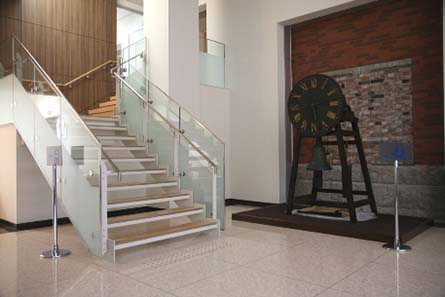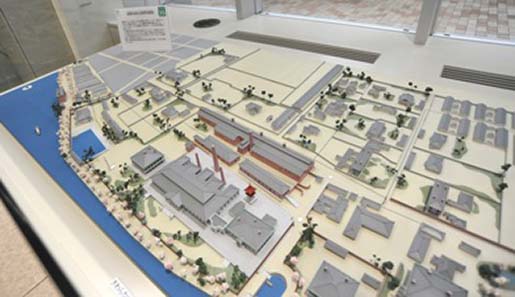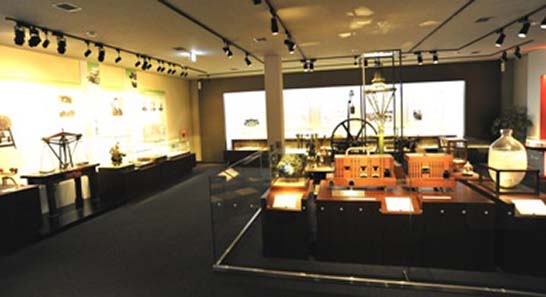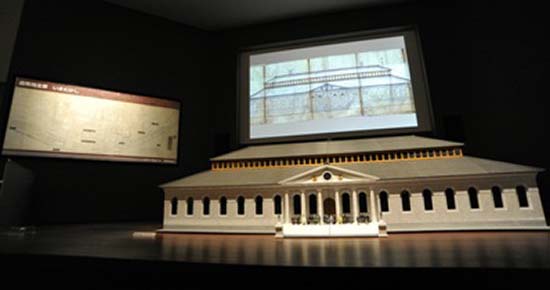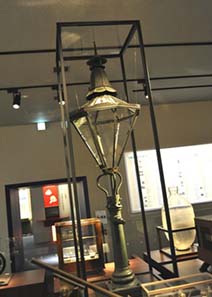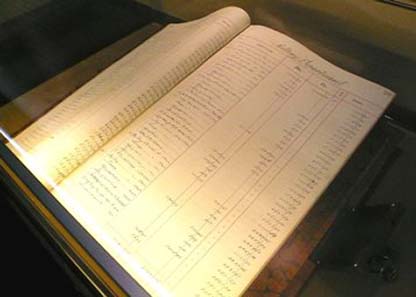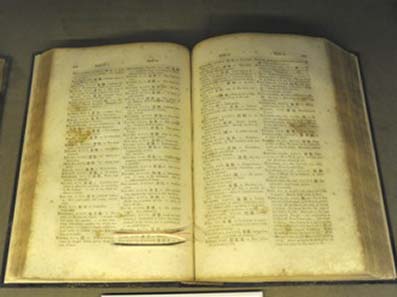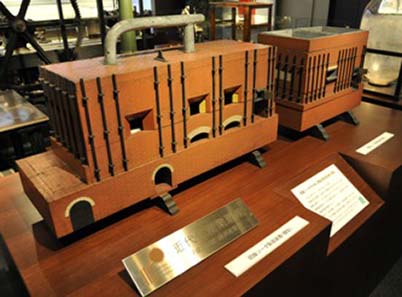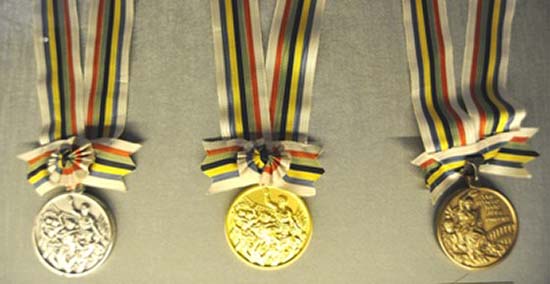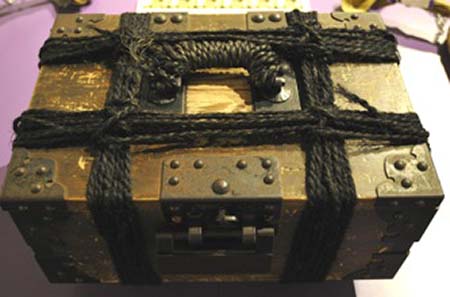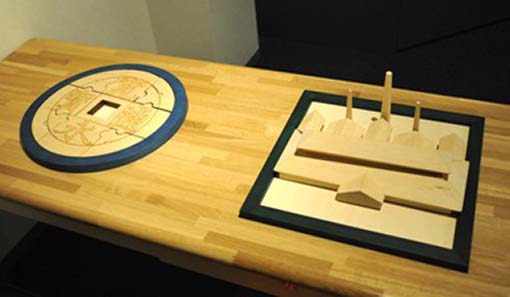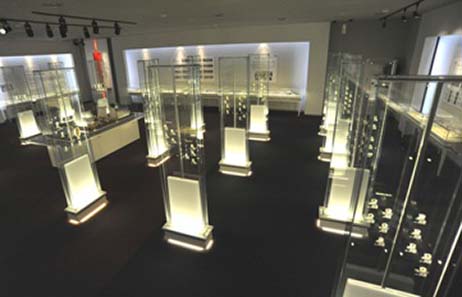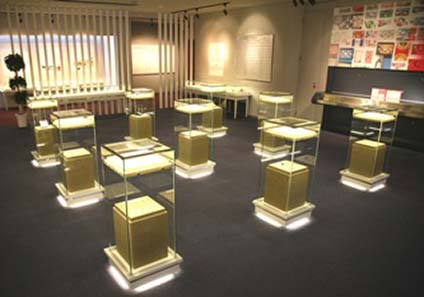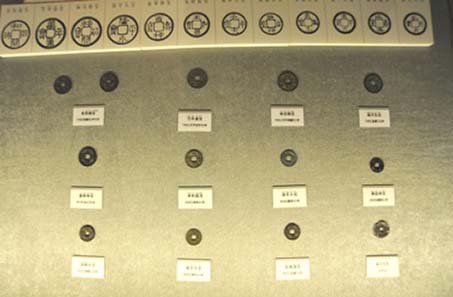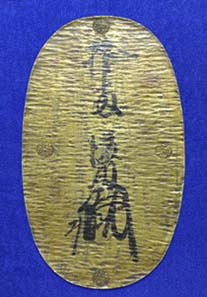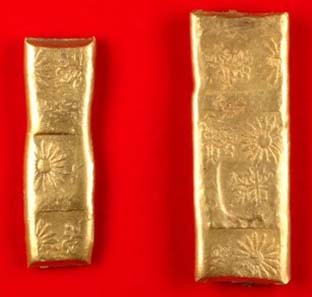July 7, 2011 – By modernizing the coinage system Japan Mint has played an important part in introducing a lot of modern and Western ways of life in Japan since its establishment in 1871: We tell you the Mint’s history and take you to it’s museum full of amazing objects illustrating the long story of coin minting in Osaka.
Japan Mint has generously permitted us to use texts and photos from their website to present the Mint and it’s spectacular museum. All Photos are by Japan Mint.
History
Japan Mint was established in Osaka by the Meiji government in order to modernize the coinage system. The inaugural ceremony was held on April 4th, 1871 and minting was commenced with Western style facilities that were epochmaking in Japan in those days.
Japan Mint at the time of its establishment (a work of C. N. Mancini).
Since heavy industry had not yet developed in Japan at that time, all heavy equipment had to be imported. In addition, factories were built within the Mint Compound for the production of sulfuric acid, soda, coal gas and coke. Telegraphic communication and telephones were set up and various light equipment such as balances and even a clock were manufactured wholly on the premises since most of the various kinds of equipment necessary for coinage were unavailable in Japan in those days. It was even necessary to manufacture ink. Another first was the adoption of double entry book keeping.
The Mint also took the lead in abolishing the traditional topknot and the wearing of swords, and in enforcing the wearing of Western clothes by the staff.
In these ways, as a pioneer in introducing European and American culture to Japan during the early years of the Meiji Era (1868 to 1912), Japan Mint played an important part in the rise of modern industry and culture in this country. Thus, it is generally said that Osaka, now the country’s center of commerce and industry is indebted to the Mint for the city’s subsequent prosperity.
From then on, with change of the times, the Mint expanded to include, in addition to the main operation of coinage, the production of orders (decorations), medals of honor and metallic art objects; the analysis and testing of metal ores and minerals; the fineness certification of precious metal wares (hallmarking) etc. The Mint became an Incorporated Administrative Agency on April 1, 2003.
Mint Museum
The Mint Museum is the only western-style brick building remaining from the Meiji era on the premises of the Japan Mint. Originally constructed as a thermal power plant, in 1969 the building was refurbished into the Mint Museum, with the facade left in its original state in order to preserve this historical building and establish a facility for introducing the Japan Mint’s activities to the public.
Major renovation were carried out in 2008 to realize a more “people-friendly, environment-friendly and fascinating museum” with new exhibition ideas. In April 2009, the Mint Museum reopened.
The Mint Museum has 4,000 of historical exhibits. You can read valuable documents, learn history of coins, and understand the close relationship between society and coins.
1st Floor – Entry Hall
The entry hall, an open-ceiling space, gives visitors a liberating feeling.
Panoramic Miniature of the Mint at the Time of its Establishment (1873)
The area of the Mint used to be twice what it is today. Originally it was about 180, 000 square meters.
Great Clock
This great clock was made by Ono Norichika in 1876, to strike on the hour in front of the factory.
It has been repaired once, and since then has been marking time as a symbol of the Mint Museum. Perhaps the ponderous sound of the bell striking the hour, as it would have sounded during the Meiji era, brings back a bit of the ambiance of those times.
2nd Floor – Exhibition Room
This exhibition, featuring materials used during the period just after the Mint’s establishment, includes “The Balance,” products that have been manufactured by the Japan Mint and panels explaining the process of manufacturing coins etc.
In addition, there are sections named “theater corner” and “experience corner.”
Image Theater
The Image Theater shows the video “History of the Japan Mint” and “Business of the Japan Mint,” with models and illuminations that move in relation to the video image.
The Balance
This balance, produced in 1876 by Ono Norichika, one of the engineers involved in the Mint’s establishment, was used to weigh production such as gold coins. This type of balance is still used in the annual coin test.
The Gas Lamp
The gas lamp was once a symbol of modernization.
At the time of the Mint’s inauguration in 1871, there were 65 gas lamps on the Mint premises and in nearby streets for outdoor lighting, and 621 gas lamps inside the factory and Mint offices for interior illumination – a total of 686 lamps.
´Oldest Double-Entry Accounting Book in Japan
The Japan Mint was first in Japan to use the double-entry bookkeeping system, under the guidance of V. E. Braga.
Japanese-English dictionary Employing Hepburn System
Since Japan at that time did not have a typographic printing system, this dictionary was printed in Shanghai in 1867. It was used by T. W. Kinder, the director of the Mint.
Miniature of Facilities for Producing Sodium Sulfate and Other Industrial Products
Utsunomiya Saburo, who was revered as an authority on chemistry, designed and supervised the construction of this miniature of the facilities for producing soda salt, crude soda and sodium sulfate.
At the time, technology had not developed to a point where it was possible to create facilities from a drawing, so a miniature like this, one-tenth actual size, was created and used as a basis for construction.
This miniature was registered by the Ministry of Economy, Trade and Industry (METI) as the “33 Heritage Constellations of Industrial Modernization: The Sequel” in February, 2009.
Tokyo Olympics Prize Medals
The 18th summer Olympics was held in Tokyo in 1964. Although there are currently no definitive standards for Olympic medals, until the 2004 Sydney Olympics the standards specified by the Olympic Charter were applied.
According to those standards, gold medals had to consist of a silver base with at least six grams of gold plating, silver medals had to have a silver concentration of at least 92.5% (100%, in the case of Japan), bronze medals had to be made of bronze, and the medals had to bear the name of the event.
Nagano Olympics Prize Medals
The 18th winter Olympics was held in Nagano in 1998. Cloisonné enamel and lacquer techniques were used for those medals.
People’s Honor Award Plaque
This award was established in 1977 to honor individuals who are widely respected by the public, give great hope to society and have attained outstanding achievements.
The Japan Mint has manufactured the plaques for this award since presentation of the plaque to Machiko Hasegawa, 10th winner of the award.
2nd Floor – Experience Corner
Senryoubako
You can lift a “Senryoubako” here. Originally a chest containing 1,000 gold “Kobang coins,” it was used for storing, saving, and carrying such coins.
Made of oak with clasp and iron band, it weighs about 20kg. Try and lift it!
Coin Bags
After inspection, approved coins are accurately counted and bagged. The new coins are delivered to the Bank of Japan via the Ministry of Finance.
For example, the 500-yen bag, containing 2,000 500-yen coins, weighs about 14kg. Can you lift it?
Gold and Silver Bullion Bars
You can touch these gold and silver bullion bars.
Wooden Puzzle
The Museum has created wooden puzzles featuring “20 yen gold coin,” “500-yen coin,” “Kanei Tsuho” and “Miniature at the Time of the Mint’s Establishment.”
Try to solve them!
3rd Floor – Exhibition Room
Here you can observe various coins illuminated by LED. Some of the coins, embedded in glass plates, can be viewed from both sides.
The exhibition on this floor includes ancient Japanese coins such as “Fuhonsen,” “Wadokaichin” and “Kochosen,” ancient Chinese coins such as “Knife money,” other old coins such as “Obang” and “Kobang,” gold and silver coins produced during the Meiji era, other commemorative coins and foreign coins.
Kochosen
The government issued 12 kinds of bronze coins from 708 to 958.
The first coin was called a “Wadokaichin” the last coin was called a “Kengentaihou.”
Tensho-Obang
“Tensho-Obang” was a gold coin made by Hideyoshi Toyotomi.
The fineness of this gold was high; it was one of the largest gold coins in the world.
Takenagashikin (Only existing specimen)
The “Takenagashikin,” manufactured during the era of Hideyoshi Toyotomi, was made by pouring gold into a bamboo-shaped cast.
This example was found in the Yodo River in Osaka in 1935.
Gold Coins Produced during the Meiji Era
Under the gold standard system, the Meiji government issued new coins to control and stabilize the circulation of currency after the Meiji Restoration. When coin design was discussed, it was initially proposed that the portrait of the emperor be used in the design.
This proposal was rejected, however, for fear that the august portrait might be profaned in circulation. For this reason, the dragon design was used instead.
We hope this tour has risen your curiosity in Japanese history and coinage. If you happen to be in Japan try to visit the Mint Museum at Osaka. The Mint Museum is open from Monday to Friday but closed on holidays and during the cherry blossom viewing week.
Time
9:00 a.m. to 4:45 p.m. (Please enter the Museum before 4:00 p.m.)
Entrance: No Admission fee
Please fill in the forms (name & address) before entering the Mint Museum at the front Gate.
Telephone Number: 06 6351 8509
Address: 1-1-79, Temma 1-chome, kita-ku, Osaka 530-0043
If you want to see a video clip of the Museum or to get further information visit this site.
On Japan Mint you will find lots of information here.
Do you know when trade between the Muromachi shogunate and Ming Dynasty started or who established “Kinza” gold mints and “Ginza” silver mints? If you do not know yet, maybe you want to take a look at the “History for kids”.
Are you so fascinated by all these stories that you want to buy Japanese coins? Visit the Japan Mint’s site for International sales.






